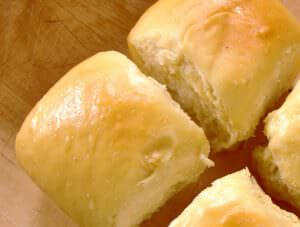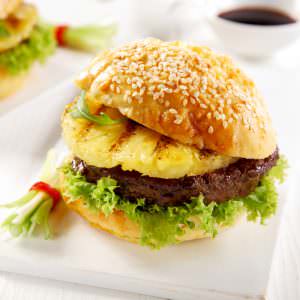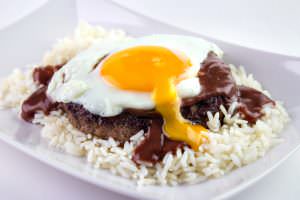There is no doubt that Hawaiians love their food. In fact, if you stop at any local restaurant, it’s not just about the taste of the “grinds,” but the quantity. When it comes to a plate lunch, Hawaiians rival Texans, when it comes to all things being bigger!
But, is your love of the luau and Hawaiian food based on lies? Yes. But, they are worth every savory, stuff-your-face bite! So, grab your melting pot and meet me in the kitchen, as we go over some local favorites that aren’t exactly native to the islands.
Sweet Bread

Speaking of melting, few things compare to a warm sweet bread biscuit with melted butter. The Hawaiian sweet bread that you can find in local grocery stores actually has roots traced to the Portuguese plantation families.
Originally baked in a round pie pan as a large loaf that everyone grabbed a handful of on the way home, this soft sweet delicacy has made itself a staple in the kitchen.
The trend to call it Hawaiian Sweet Bread is actually fairly recent, with the popular Hawaii-based bakery taking it out of home kitchens and making it a staple in grocery stores and big box chains around the country.
It’s used for everything from French toast to sandwich bread to dinner rolls. But, if you want to be a purist, grab a round loaf and forget the knife. Literally grab a handful on your way out the door. It’s so good, you really don’t even need butter.
Lomi Lomi Salmon
When you go to the luau, you will be overwhelmed with the variety of food presented to you. One of the options is lomi lomi salmon, salted salmon mixed with sweet onions, tomatoes, and green onion, sometimes with a kick of chili pepper.
Please don’t buy the little white lie that lomi lomi salmon is part of a traditional luau in the sense of ancient Hawaiian foods. Trust me, King Kamehameha I wasn’t taking his canoe to Alaska to stock up on salmon for the next big celebration.
You’re catching on. Salmon isn’t indigenous to Hawaii. But, that isn’t to say that is doesn’t fit into the fish-eating culture of the islands. Hawaii was a major ship port for whalers and freighters. Probably introduced by Russian sailors, the dish was more likely popularized by local Hawaiians bringing back the fish after long stints as ship crewman, dating as far back as the 1700s.
Hawaiian Teriyaki Burger

The teriyaki burger is like the holy grail of burgers, with chefs around the world trying to create the perfect blend of sweet, savory and tart in every bite. Teriyaki is actually a Japanese marinade, mixing a base of brown sugar and shoyu (soy sauce).
Everyone has a twist on it, mixing sake or mirin with, it as well as spices such as ginger or pepper. But, where teriyaki sauce and burgers are found, you can surely find a ring of pineapple as the key accouterment, warranting the name Hawaiian Burger and giving this dish a double whammy for not being truly Hawaiian.
Sure, Hawaii has a large pineapple industry. At one point, Dole Plantation was the worldwide leader of pineapple canning and export. Today, Hawaii still accounts for approximately 60% of canned pineapple production.
The fruit is native to Brazil and Paraguay and while introduced to Hawaii in the early 1500s, it wasn’t until James Dole, the “Pineapple King,” arrived, that it became a key part of Hawaii’s industry in the early 1900s. Don’t worry, even the locals like the burger, but shorten the name to teri-burger to expedite ordering.
Poke
Poke is a local staple, with exceptional poke and poke bowls sold everywhere from local grocery stores to fine dining restaurants. The word is pronounced, POH-KAY, so don’t be that guy that makes the joke about a poke in the eye. The word means “to cut cross-wise.” Ahi, or Hawaiian tuna, is the most common type of fish used, but everything from scallops to octopus find itself on the poke menu.
Hawaiian’s love for poke stems simply from their love of fish. But, it is a fusion dish, mixing elements of Japanese soy marinades with local seaweeds and rich spicy seasonings. No matter whether you like spicy or sweet, there is a poke style that meets your needs.
And, for those not daring enough to eat raw fish, there are even a few styles where the fish is seared before it is marinated. Take the appetizer and make it a meal by incorporating rice and avocado for a poke bowl that is sure to satisfy your hunger, as well as your taste buds.
Loco Moco

Loco moco sounds more like an insult than your lunch order. But, to Hawaiians this is the ultimate plate lunch and the original Hawaiian fast food. While it is a local favorite, there is little culturally Hawaiian about it.
Similar to SPAM’s rise in popularity during post World War II, loco moco found its roots in the same time period. There are many variations to it. But, at its core, it is a couple scoops of rice topped with a hamburger patty and sunnyside up egg. And, don’t forget the slathering of gravy over all of it.
To look at this dish, you might think you’re in the Southern States, but it is a Hawaiian tradition. For those curious about the name, loco moco was named after the nickname of the kid on the Big Island who made it popular. His nickname was “loco” – crazy in Portuguese. Moco means nothing, except it rhymed and locals have been asking for this crazy meal ever since.
Hawaiian food lore is extensive, so don’t think this list is the all-inclusive one. Check out a few others.










